 三角関数
三角関数
 三角関数
三角関数
福田のわかった数学〜高校2年生083〜三角関数(23)18°系の三角比(3)
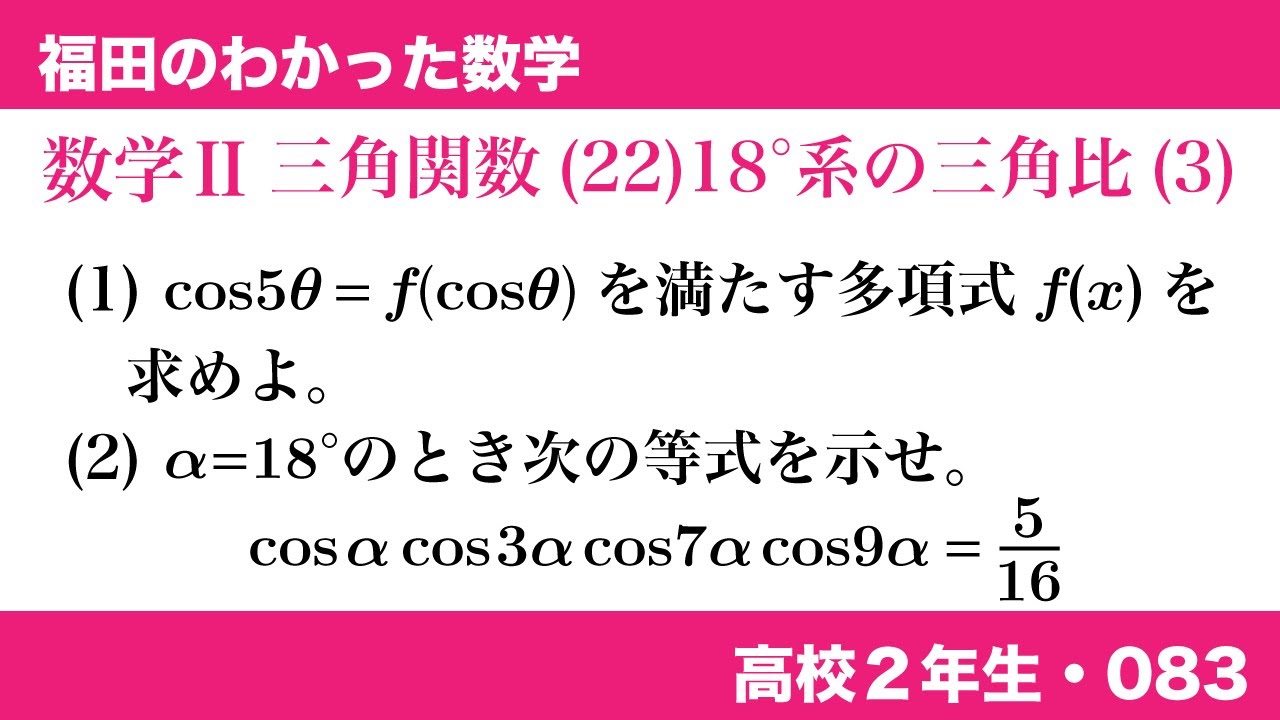
単元:
#数Ⅱ#三角関数#加法定理とその応用#数学(高校生)
指導講師:
福田次郎
問題文全文(内容文):
数学$\textrm{II}$三角関数(22) 18°系の三角比(3)
(1)$\cos5\theta=f(\cos\theta)$を満たす多項式f(x)を求めよ。
(2)$\alpha=18°$のとき次の等式を示せ。
$\cos\alpha\cos3\alpha\cos7\alpha\cos9\alpha=\frac{5}{16}$
この動画を見る
数学$\textrm{II}$三角関数(22) 18°系の三角比(3)
(1)$\cos5\theta=f(\cos\theta)$を満たす多項式f(x)を求めよ。
(2)$\alpha=18°$のとき次の等式を示せ。
$\cos\alpha\cos3\alpha\cos7\alpha\cos9\alpha=\frac{5}{16}$
福田のわかった数学〜高校2年生082〜三角関数(21)18°系の三角比(2)
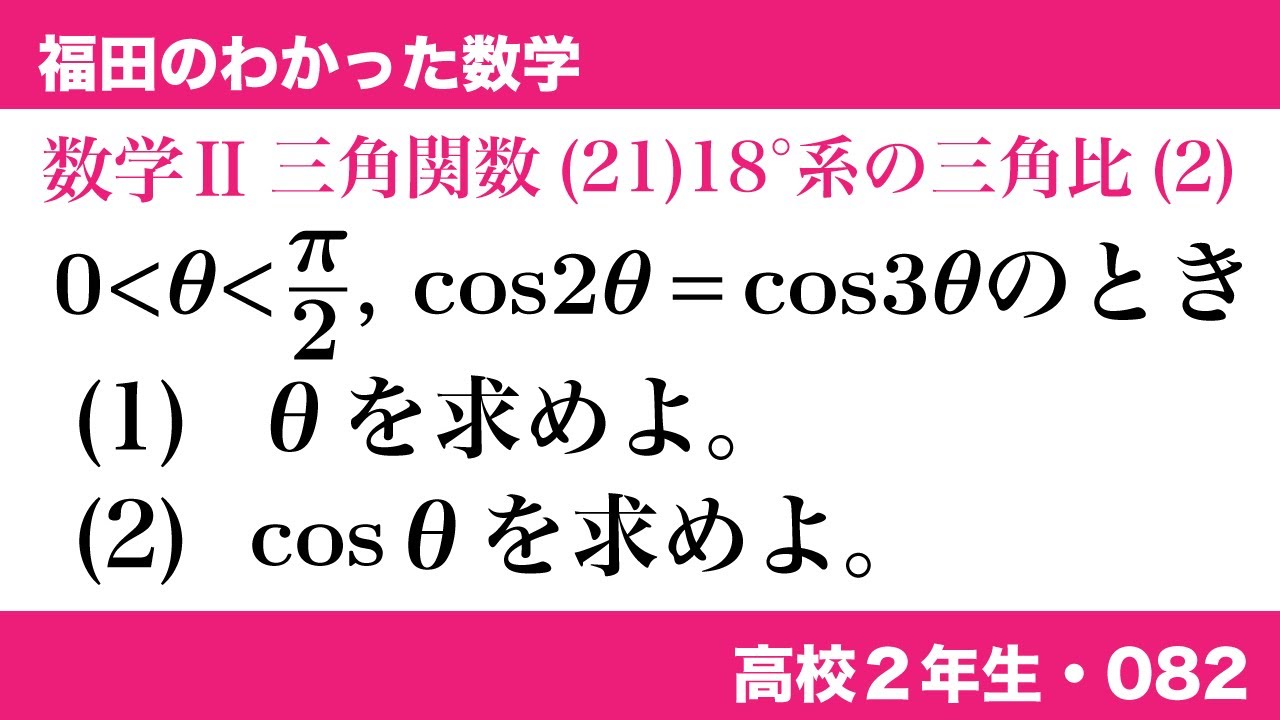
単元:
#数Ⅱ#三角関数#加法定理とその応用#数学(高校生)
指導講師:
福田次郎
問題文全文(内容文):
数学$\textrm{II}$ 三角関数(21) 18°系の三角比(2)
$0 \lt \theta \lt \frac{\pi}{2}, \cos2\theta=\cos3\theta$のとき
(1)$\theta$を求めよ。
(2)$\cos\theta$を求めよ。
この動画を見る
数学$\textrm{II}$ 三角関数(21) 18°系の三角比(2)
$0 \lt \theta \lt \frac{\pi}{2}, \cos2\theta=\cos3\theta$のとき
(1)$\theta$を求めよ。
(2)$\cos\theta$を求めよ。
福田のわかった数学〜高校2年生081〜三角関数(20)18°系の三角比(1)
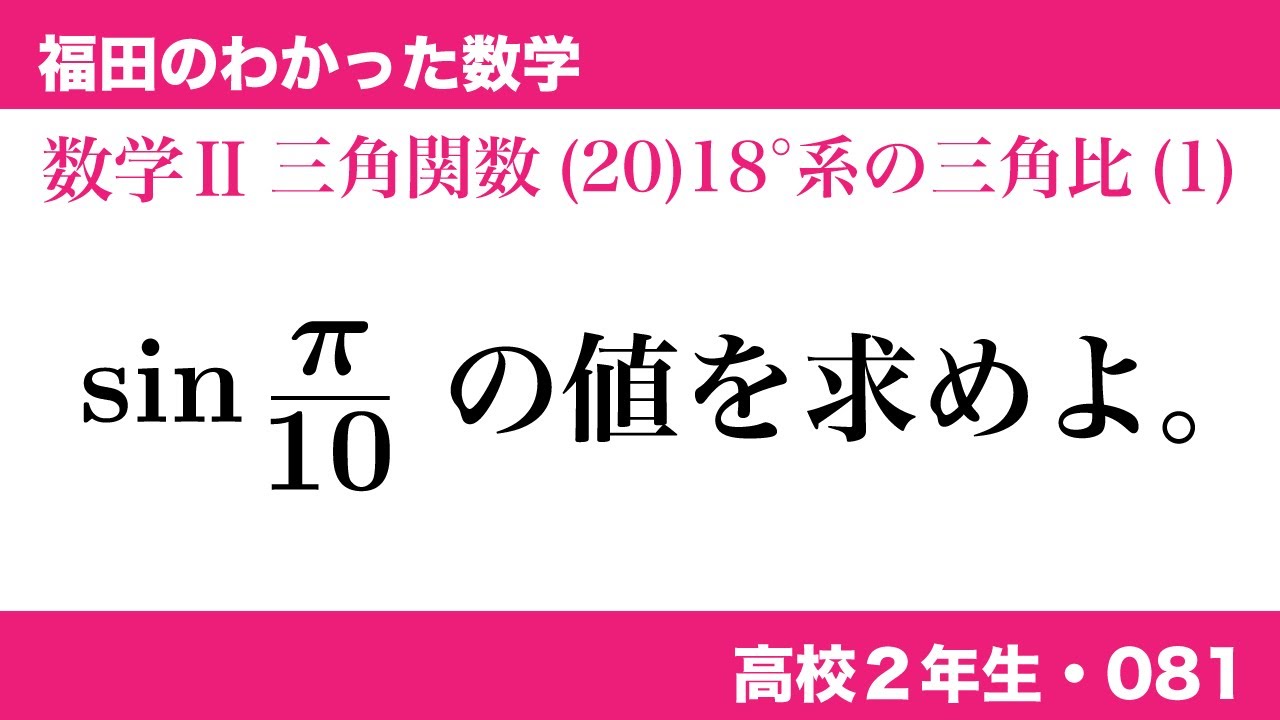
単元:
#数Ⅱ#三角関数#加法定理とその応用#数学(高校生)
指導講師:
福田次郎
問題文全文(内容文):
数学$\textrm{II}$ 三角関数(20) 18°系の三角比(1)
$\sin\frac{\pi}{10}$の値を求めよ。
この動画を見る
数学$\textrm{II}$ 三角関数(20) 18°系の三角比(1)
$\sin\frac{\pi}{10}$の値を求めよ。
福田のわかった数学〜高校2年生080〜三角関数(19)2直線のなす角(3)

単元:
#数Ⅱ#三角関数#加法定理とその応用#数学(高校生)
指導講師:
福田次郎
問題文全文(内容文):
数学$\textrm{II}$ 三角関数(19) なす角(3)
2点A(0,2), B(0,8)がある。点P(a,0) $(a \gt 0)$について$\angle APB$が最大となるaは?
この動画を見る
数学$\textrm{II}$ 三角関数(19) なす角(3)
2点A(0,2), B(0,8)がある。点P(a,0) $(a \gt 0)$について$\angle APB$が最大となるaは?
三角関数基本
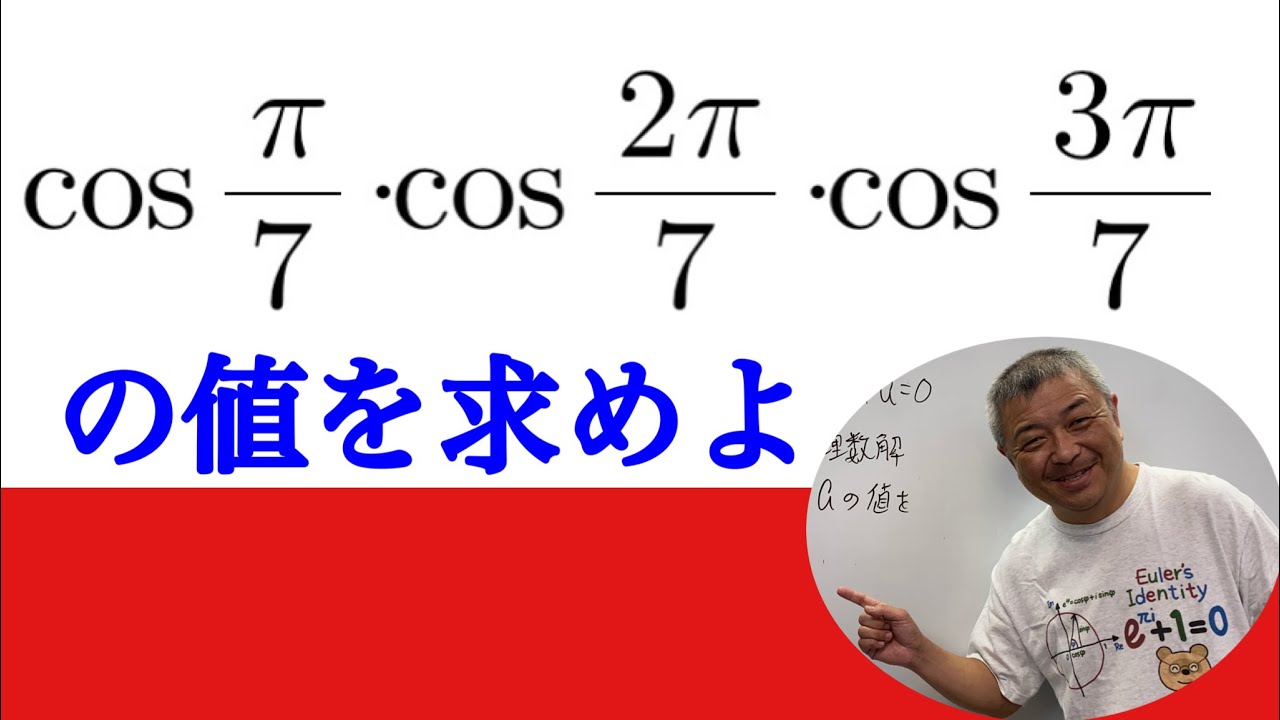
単元:
#数Ⅱ#三角関数#三角関数とグラフ#数学(高校生)
指導講師:
鈴木貫太郎
問題文全文(内容文):
値を求めよ.
$\cos \dfrac{\pi}{7}・\cos \dfrac{2\pi}{7}・\cos\dfrac{3\pi}{7}$
この動画を見る
値を求めよ.
$\cos \dfrac{\pi}{7}・\cos \dfrac{2\pi}{7}・\cos\dfrac{3\pi}{7}$
福田のわかった数学〜高校2年生079〜三角関数(18)2直線のなす角(2)

単元:
#数Ⅱ#三角関数#加法定理とその応用#数学(高校生)
指導講師:
福田次郎
問題文全文(内容文):
数学$\textrm{II}$ 三角関数(18) なす角(2)
$y=3x+1$と$\frac{\pi}{6}$の角をなし、原点を通る直線の方程式を求めよ。
この動画を見る
数学$\textrm{II}$ 三角関数(18) なす角(2)
$y=3x+1$と$\frac{\pi}{6}$の角をなし、原点を通る直線の方程式を求めよ。
福田のわかった数学〜高校2年生078〜三角関数(17)2直線のなす角(1)
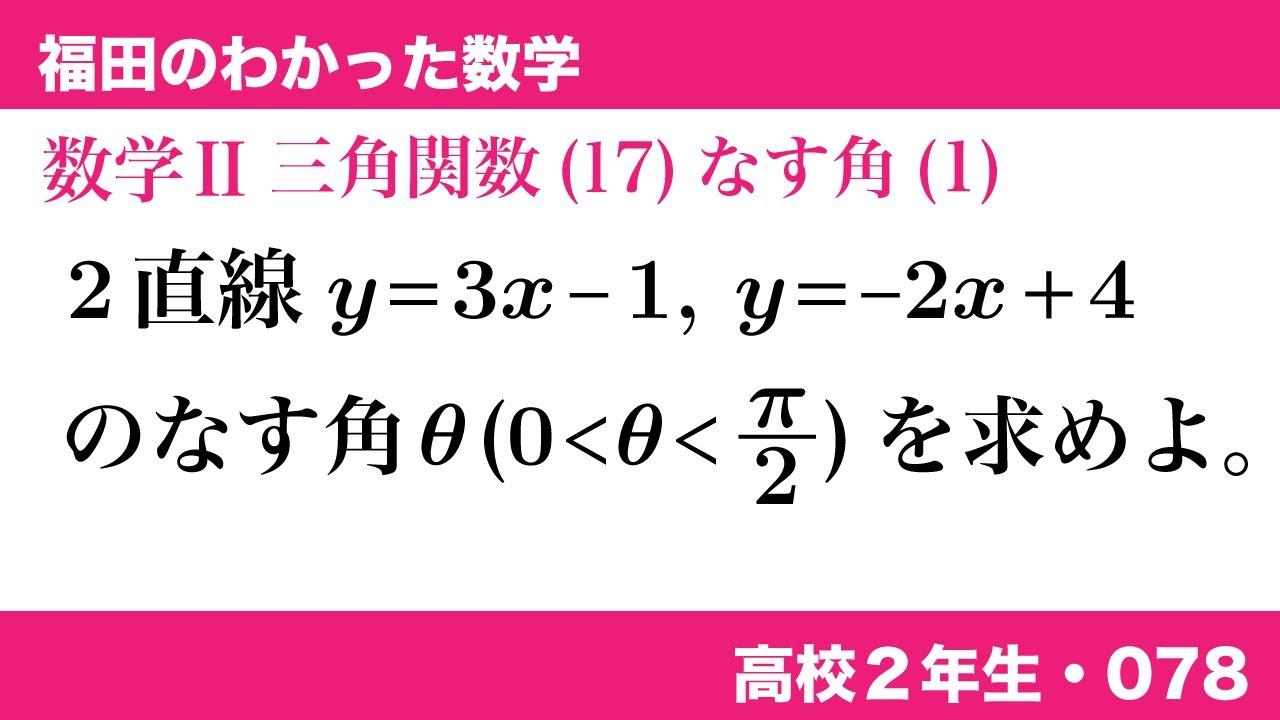
単元:
#数Ⅱ#三角関数#加法定理とその応用#数学(高校生)
指導講師:
福田次郎
問題文全文(内容文):
数学$\textrm{II}$ 三角関数(17) なす角(1)
2直線$y=3x-1, y=-2x+4$
のなす角$\theta(0 \lt \theta \lt \frac{\pi}{2})$を求めよ。
この動画を見る
数学$\textrm{II}$ 三角関数(17) なす角(1)
2直線$y=3x-1, y=-2x+4$
のなす角$\theta(0 \lt \theta \lt \frac{\pi}{2})$を求めよ。
福田のわかった数学〜高校2年生077〜三角関数(16)三角関数の最大最小
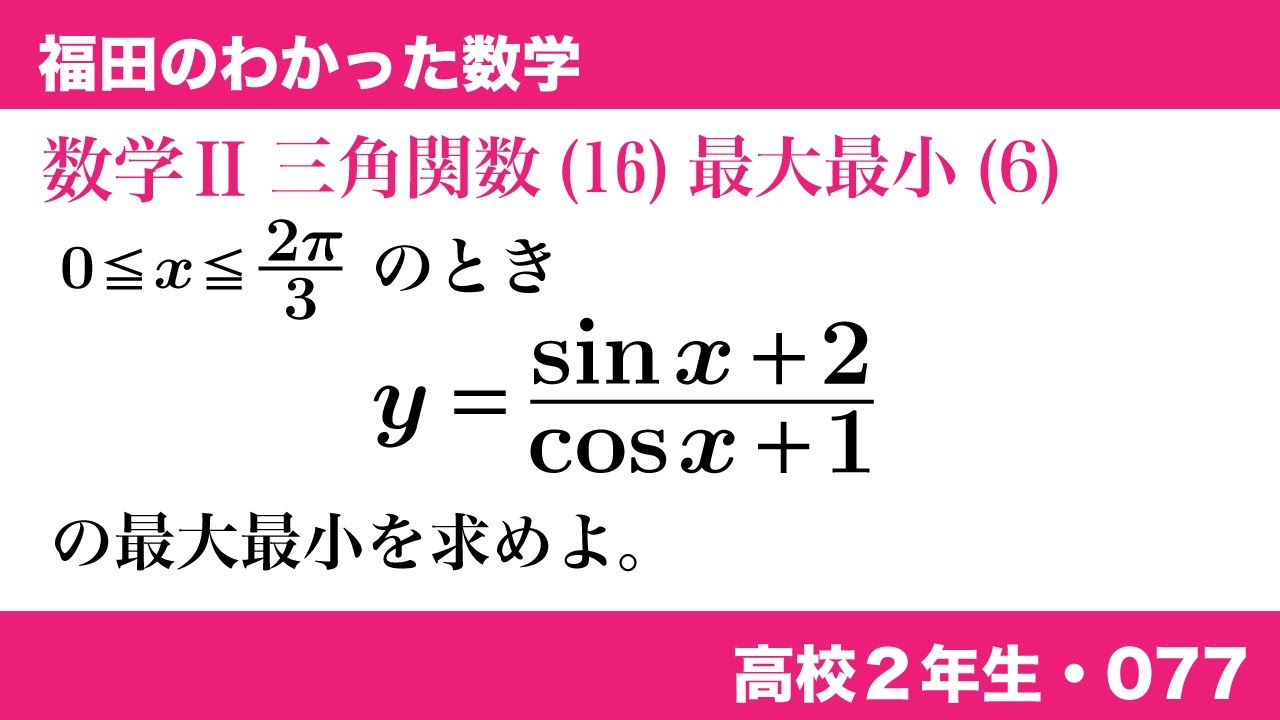
単元:
#数Ⅱ#三角関数#数学(高校生)
指導講師:
福田次郎
問題文全文(内容文):
数学$\textrm{II}$ 三角関数(16) 最大最小(6)
$y=\frac{\sin x+2}{\cos x+1} (0 \leqq x \leqq \frac{2\pi}{3})$の最大値、最小値を求めよ。
この動画を見る
数学$\textrm{II}$ 三角関数(16) 最大最小(6)
$y=\frac{\sin x+2}{\cos x+1} (0 \leqq x \leqq \frac{2\pi}{3})$の最大値、最小値を求めよ。
福田のわかった数学〜高校2年生076〜三角関数(15)三角関数の最大最小
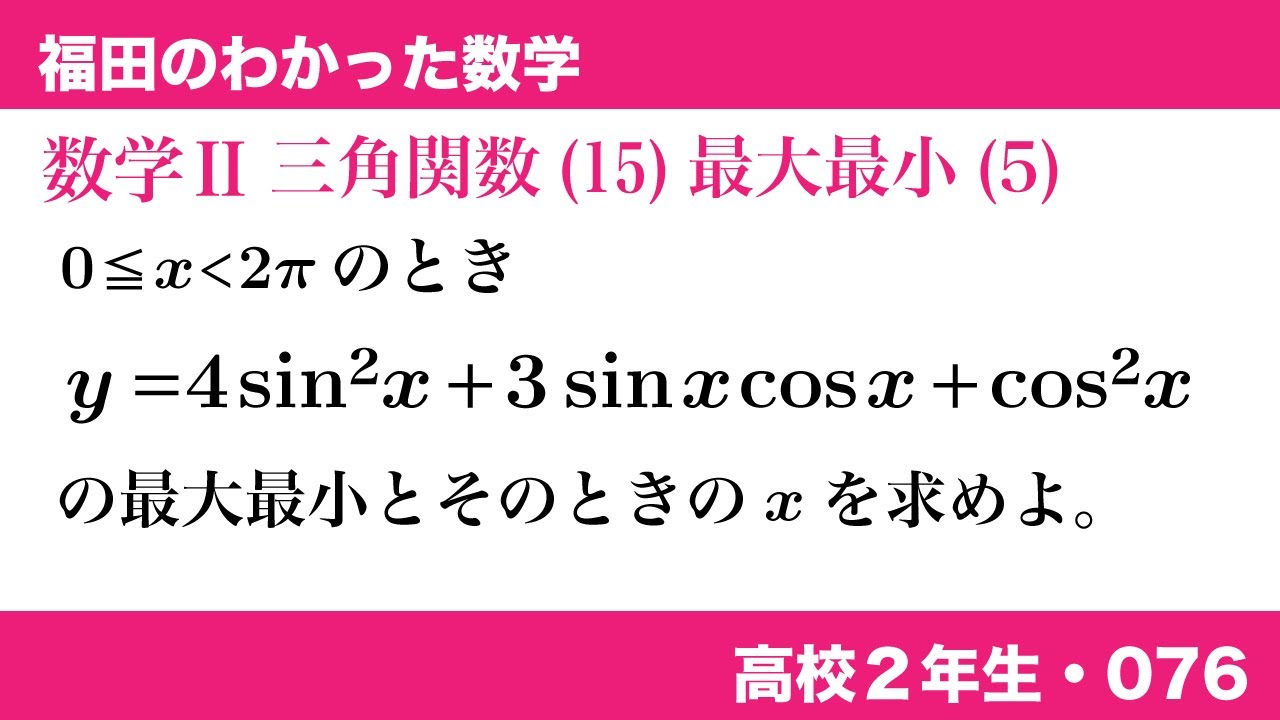
単元:
#数Ⅱ#三角関数#数学(高校生)
指導講師:
福田次郎
問題文全文(内容文):
数学$\textrm{II}$ 三角関数(15) 最大最小(5)
$y=4\sin^2x+3\sin x\cos x+\cos^2x (0 \leqq x \lt 2\pi)$の最大値、最小値と
そのときのxの値を求めよ。
この動画を見る
数学$\textrm{II}$ 三角関数(15) 最大最小(5)
$y=4\sin^2x+3\sin x\cos x+\cos^2x (0 \leqq x \lt 2\pi)$の最大値、最小値と
そのときのxの値を求めよ。
福田のわかった数学〜高校2年生075〜三角関数(14)三角関数の最大最小
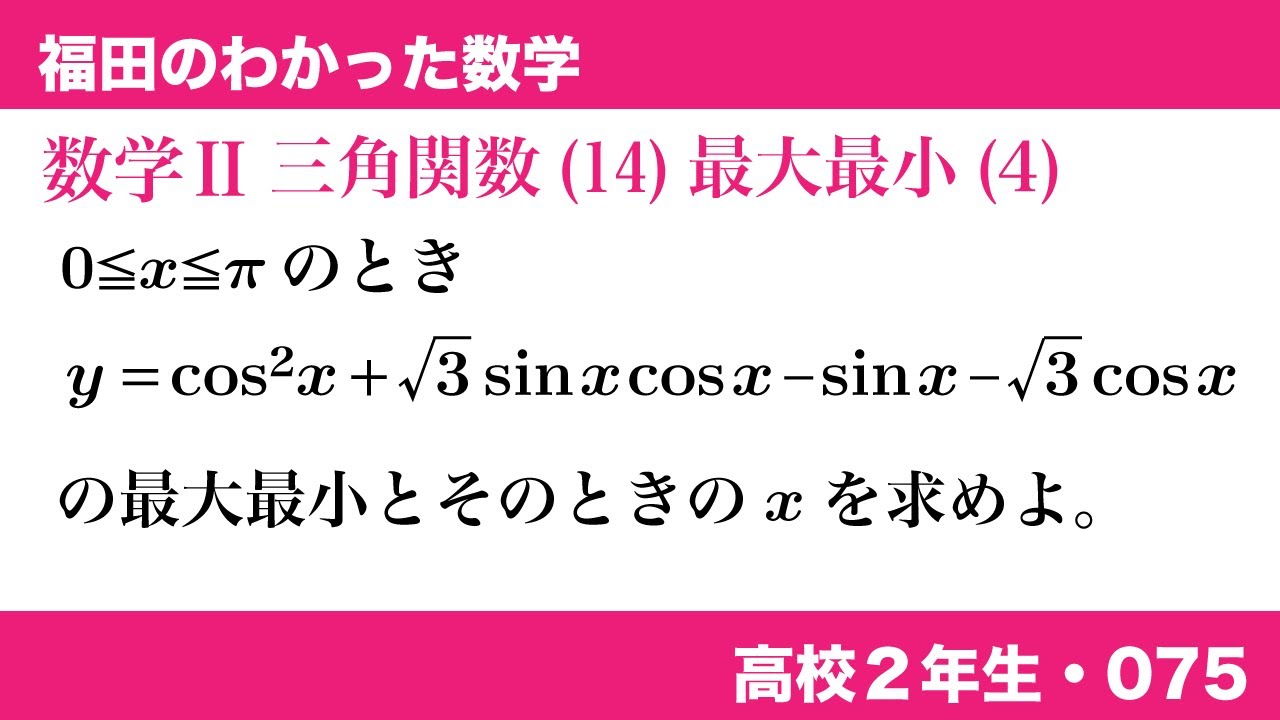
単元:
#数Ⅱ#三角関数#数学(高校生)
指導講師:
福田次郎
問題文全文(内容文):
数学$\textrm{II}$ 三角関数(14) 最大最小(4)
$y=\cos^2x+\sqrt3\sin x\cos x-\sin x-\sqrt3\cos x (0 \leqq x \leqq \pi)$
の最大値、最小値とそのときのxの値を求めよ。
この動画を見る
数学$\textrm{II}$ 三角関数(14) 最大最小(4)
$y=\cos^2x+\sqrt3\sin x\cos x-\sin x-\sqrt3\cos x (0 \leqq x \leqq \pi)$
の最大値、最小値とそのときのxの値を求めよ。
福田のわかった数学〜高校3年生理系092〜グラフを描こう(14)三角関数、凹凸、漸近線
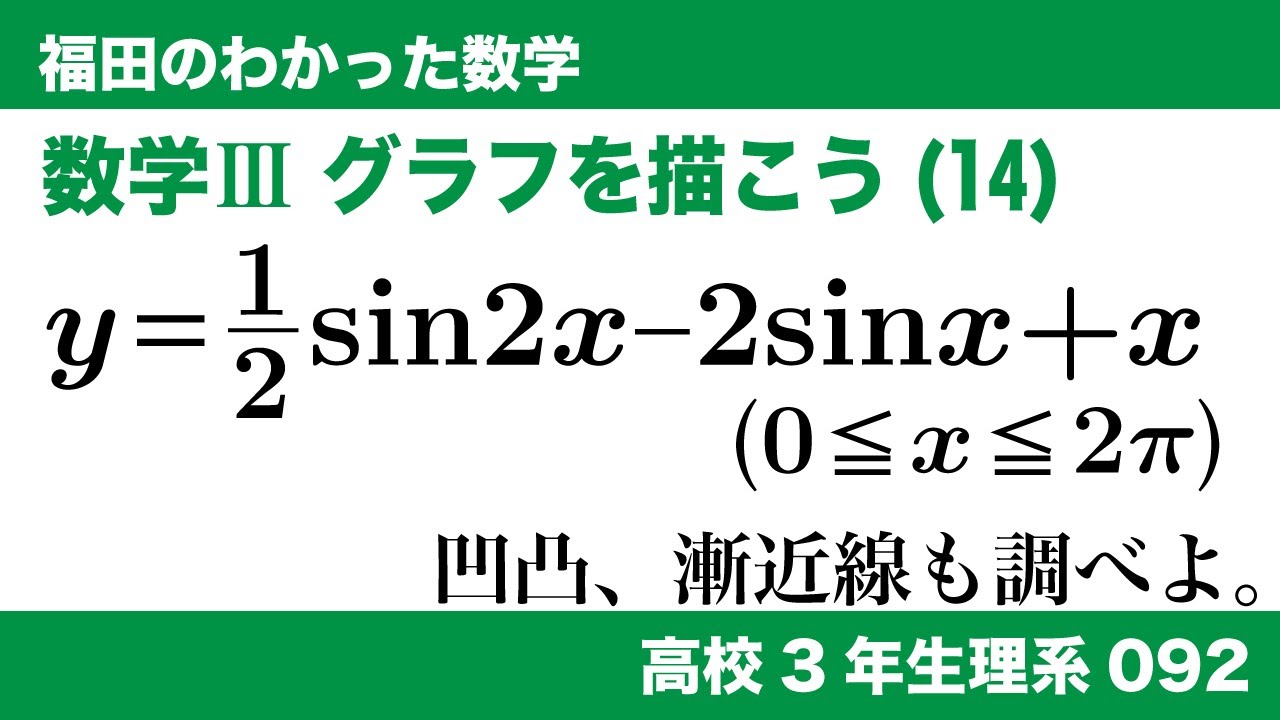
単元:
#数Ⅱ#三角関数#微分とその応用#関数の変化(グラフ・最大最小・方程式・不等式)#数学(高校生)#数Ⅲ
指導講師:
福田次郎
問題文全文(内容文):
数学$\textrm{III}$ グラフを描こう(14)
$y=\frac{1}{2}\sin2x-2\sin x+x (0 \leqq x \leqq 2\pi)$のグラフを描け。凹凸、漸近線も調べよ。
この動画を見る
数学$\textrm{III}$ グラフを描こう(14)
$y=\frac{1}{2}\sin2x-2\sin x+x (0 \leqq x \leqq 2\pi)$のグラフを描け。凹凸、漸近線も調べよ。
#28 数検1級1次 過去問 Arctanの加法定理
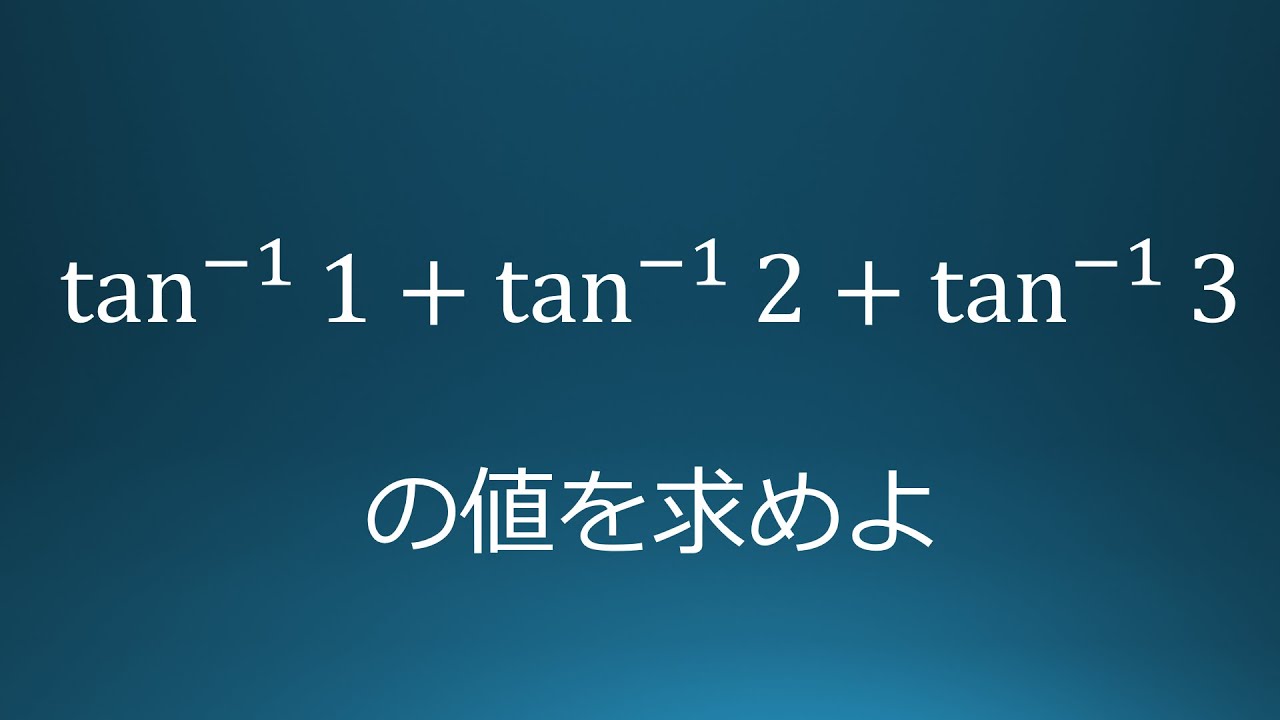
単元:
#数Ⅱ#数学検定・数学甲子園・数学オリンピック等#三角関数#三角関数とグラフ#数学検定#数学検定1級
指導講師:
ますただ
問題文全文(内容文):
$\tan^{-1}1+\tan^{-1}2+\tan^{-1}3$の値を求めよ。
この動画を見る
$\tan^{-1}1+\tan^{-1}2+\tan^{-1}3$の値を求めよ。
福田のわかった数学〜高校2年生074〜三角関数(13)三角関数の最大最小

単元:
#数Ⅱ#三角関数#加法定理とその応用#数学(高校生)
指導講師:
福田次郎
問題文全文(内容文):
数学$\textrm{II}$ 三角関数(13) 最大最小(3)
$y=a(\sin x+\cos x)+\sin2x$の最大値、最小値を求めよ。ただし、$a \gt 0$とする。
この動画を見る
数学$\textrm{II}$ 三角関数(13) 最大最小(3)
$y=a(\sin x+\cos x)+\sin2x$の最大値、最小値を求めよ。ただし、$a \gt 0$とする。
福田のわかった数学〜高校2年生073〜三角関数(12)三角関数の最大最小
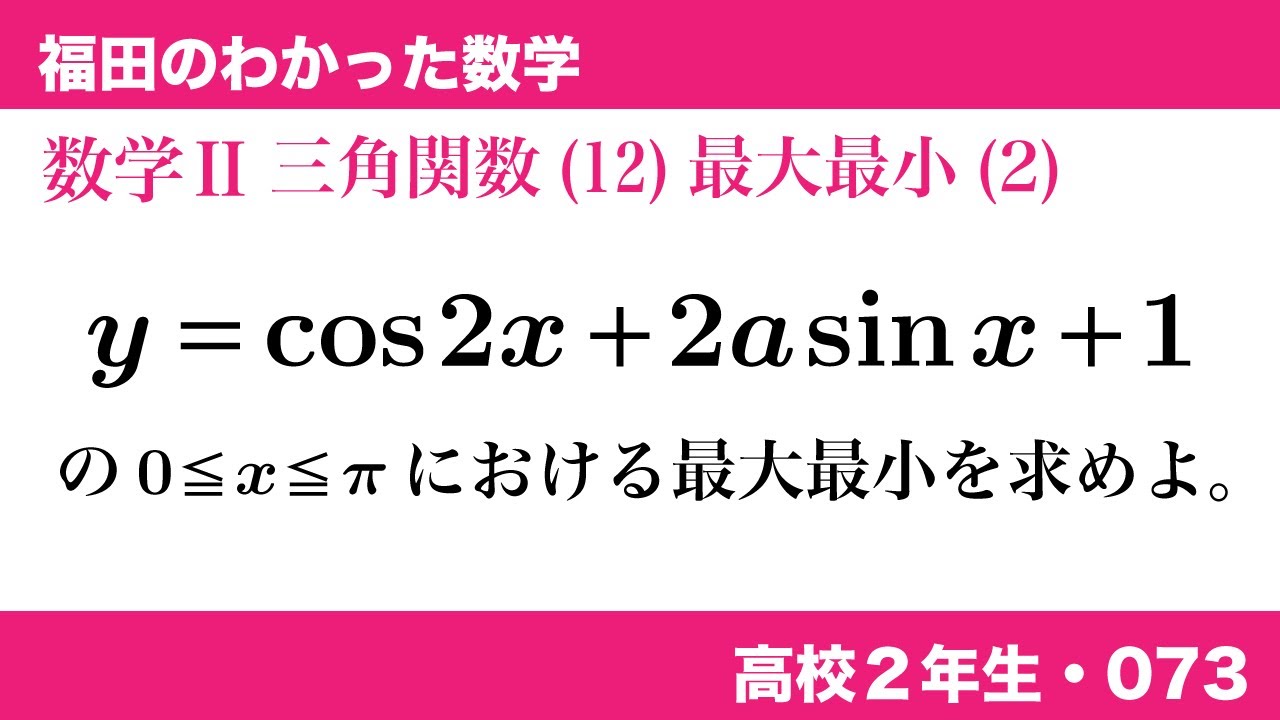
単元:
#数Ⅱ#三角関数#加法定理とその応用#数学(高校生)
指導講師:
福田次郎
問題文全文(内容文):
数学$\textrm{II}$ 三角関数(12) 最大最小(2)
$y=\cos2x+2a\sin x+1$
の$0 \leqq x \leqq \pi$における最大値、最小値を求めよ。
この動画を見る
数学$\textrm{II}$ 三角関数(12) 最大最小(2)
$y=\cos2x+2a\sin x+1$
の$0 \leqq x \leqq \pi$における最大値、最小値を求めよ。
福田のわかった数学〜高校2年生072〜三角関数(11)三角関数の最大最小
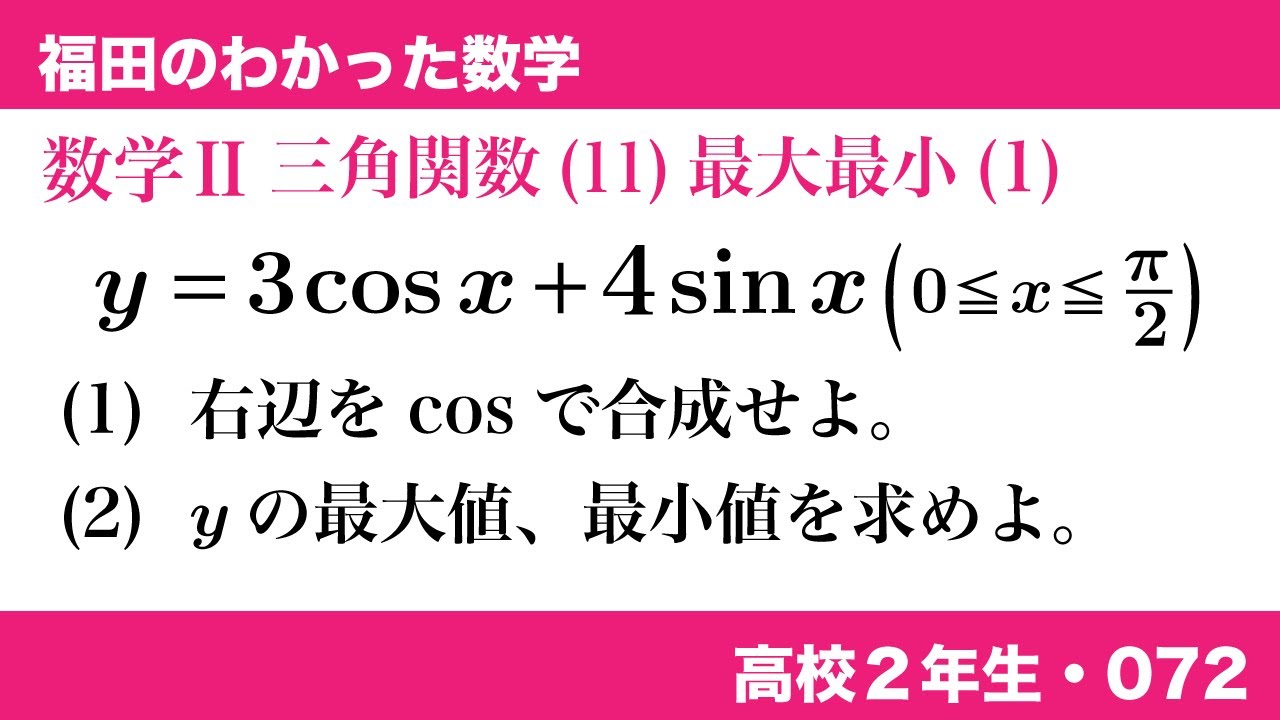
単元:
#数Ⅱ#三角関数#加法定理とその応用#数学(高校生)
指導講師:
福田次郎
問題文全文(内容文):
数学$\textrm{II}$ 三角関数(11) 最大最小(1)
$y=3\cos x+4\sin x (0 \leqq x \leqq \frac{\pi}{2})$
(1)右辺を$\cos$で合成せよ。
(2)yの最大値、最小値を求めよ。
この動画を見る
数学$\textrm{II}$ 三角関数(11) 最大最小(1)
$y=3\cos x+4\sin x (0 \leqq x \leqq \frac{\pi}{2})$
(1)右辺を$\cos$で合成せよ。
(2)yの最大値、最小値を求めよ。
福田のわかった数学〜高校2年生071〜三角関数(10)三角方程式の解の個数

単元:
#数Ⅱ#三角関数#三角関数とグラフ#数学(高校生)
指導講師:
福田次郎
問題文全文(内容文):
数学$\textrm{II}$ 三角関数(10) 解の個数
$3\cos^2x-\sin x-a=0$
の$0 \leqq x \leqq \frac{3\pi}{2}$の範囲にある解の個数を、実数$a$の値によって分類せよ。
この動画を見る
数学$\textrm{II}$ 三角関数(10) 解の個数
$3\cos^2x-\sin x-a=0$
の$0 \leqq x \leqq \frac{3\pi}{2}$の範囲にある解の個数を、実数$a$の値によって分類せよ。
福田のわかった数学〜高校2年生070〜三角関数(9)三角方程式の共通解
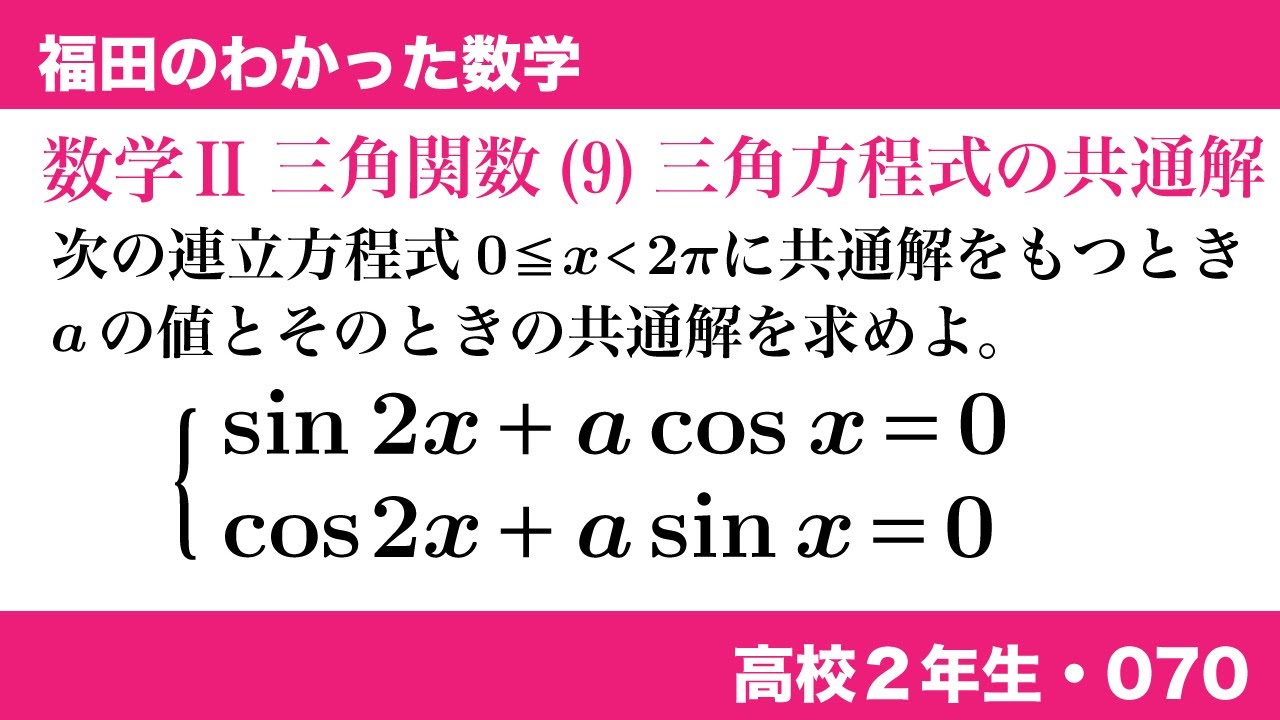
単元:
#数Ⅱ#図形と方程式#三角関数#三角関数とグラフ#数学(高校生)
指導講師:
福田次郎
問題文全文(内容文):
数学$\textrm{II}$ 三角関数(9) 三角方程式の共通解
次の連立方程式$0 \leqq x \lt 2\pi$に共通解をもつとき
aの値とそのときの共通解を求めよ。
$\begin{eqnarray}
\left\{
\begin{array}{l}
\sin2x+a\cos x=0 \\
\cos2x+a\sin x=0
\end{array}
\right.
\end{eqnarray}$
この動画を見る
数学$\textrm{II}$ 三角関数(9) 三角方程式の共通解
次の連立方程式$0 \leqq x \lt 2\pi$に共通解をもつとき
aの値とそのときの共通解を求めよ。
$\begin{eqnarray}
\left\{
\begin{array}{l}
\sin2x+a\cos x=0 \\
\cos2x+a\sin x=0
\end{array}
\right.
\end{eqnarray}$
福田のわかった数学〜高校2年生069〜三角関数(8)三角不等式
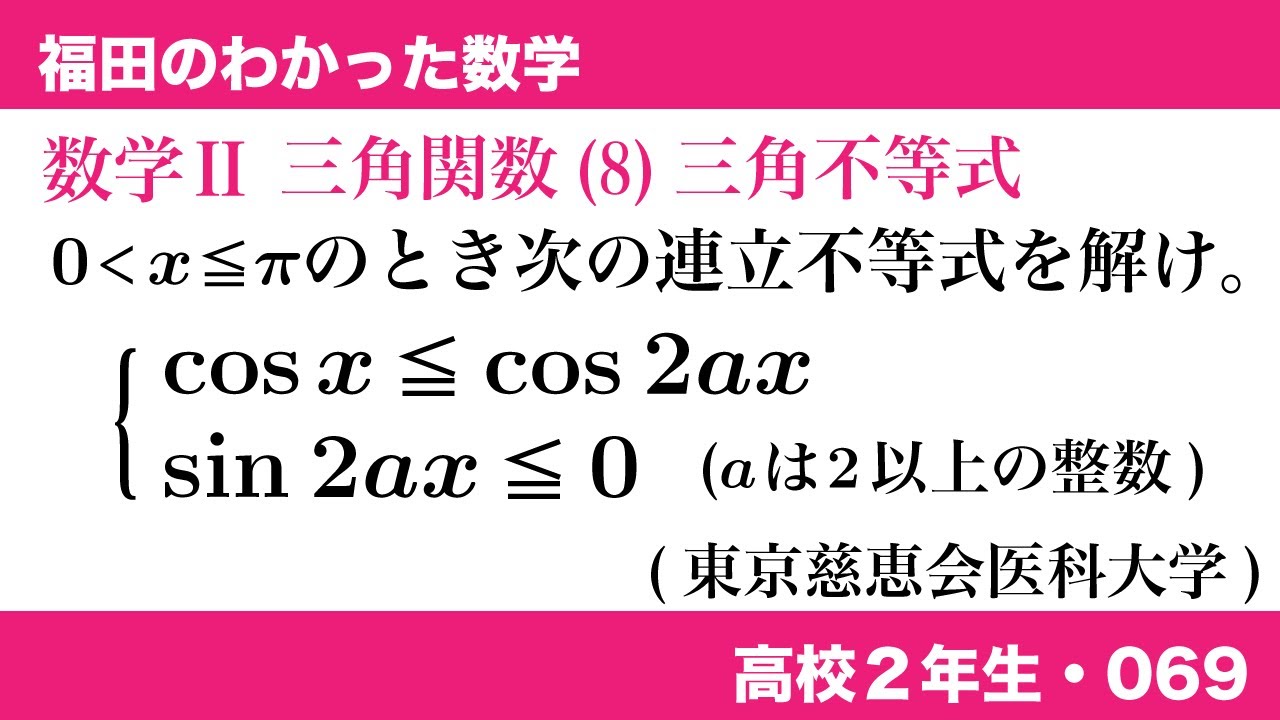
単元:
#数Ⅱ#三角関数#三角関数とグラフ#数学(高校生)
指導講師:
福田次郎
問題文全文(内容文):
数学$\textrm{II}$ 三角関数(8) 三角不等式
aは2以上の整数、$0 \lt x \leqq \pi$のとき次の連立不等式を解け。
$\begin{eqnarray}
\left\{
\begin{array}{l}
\cos x \leqq \cos2ax \ldots① \\
\sin2ax \leqq 0 \ldots②
\end{array}
\right.
\end{eqnarray}$
この動画を見る
数学$\textrm{II}$ 三角関数(8) 三角不等式
aは2以上の整数、$0 \lt x \leqq \pi$のとき次の連立不等式を解け。
$\begin{eqnarray}
\left\{
\begin{array}{l}
\cos x \leqq \cos2ax \ldots① \\
\sin2ax \leqq 0 \ldots②
\end{array}
\right.
\end{eqnarray}$
【数Ⅱ】三角関数:方程式6x²-xy-y²=0は交わる2直線を表す。このとき、2直線のなす角θ(0≦θ≦π/2)を求めよ。
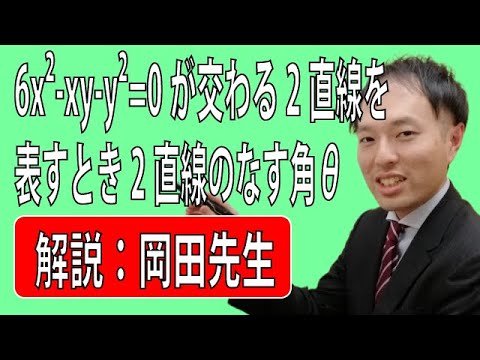
単元:
#数Ⅱ#三角関数#加法定理とその応用#数学(高校生)
指導講師:
理数個別チャンネル
問題文全文(内容文):
方程式$6x^2-xy-y^2=0$は交わる2直線を表す。このとき、2直線のなす角$\theta(0\leqq\theta\leqq \dfrac{\pi}{2}$)を求めよ。
この動画を見る
方程式$6x^2-xy-y^2=0$は交わる2直線を表す。このとき、2直線のなす角$\theta(0\leqq\theta\leqq \dfrac{\pi}{2}$)を求めよ。
【数Ⅱ】三角関数:方程式sin(θ+40°)=sinθ(ただし0°≦θ≦90°)をみたすθを求めよ。
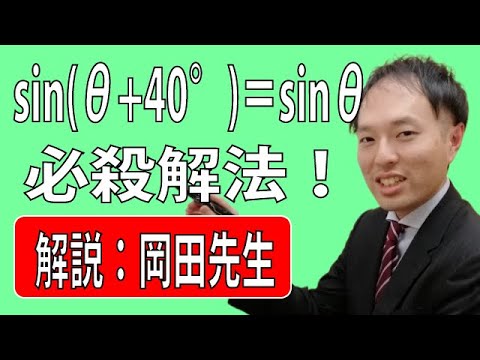
単元:
#数Ⅱ#三角関数#加法定理とその応用#数学(高校生)
指導講師:
理数個別チャンネル
問題文全文(内容文):
方程式$\sin(\theta+40°)=\sin\theta$(ただし$0°\leqq\theta\leqq90°$)をみたす$\theta$を求めよ。
この動画を見る
方程式$\sin(\theta+40°)=\sin\theta$(ただし$0°\leqq\theta\leqq90°$)をみたす$\theta$を求めよ。
福田のわかった数学〜高校2年生068〜三角関数(7)三角方程式とグラフ
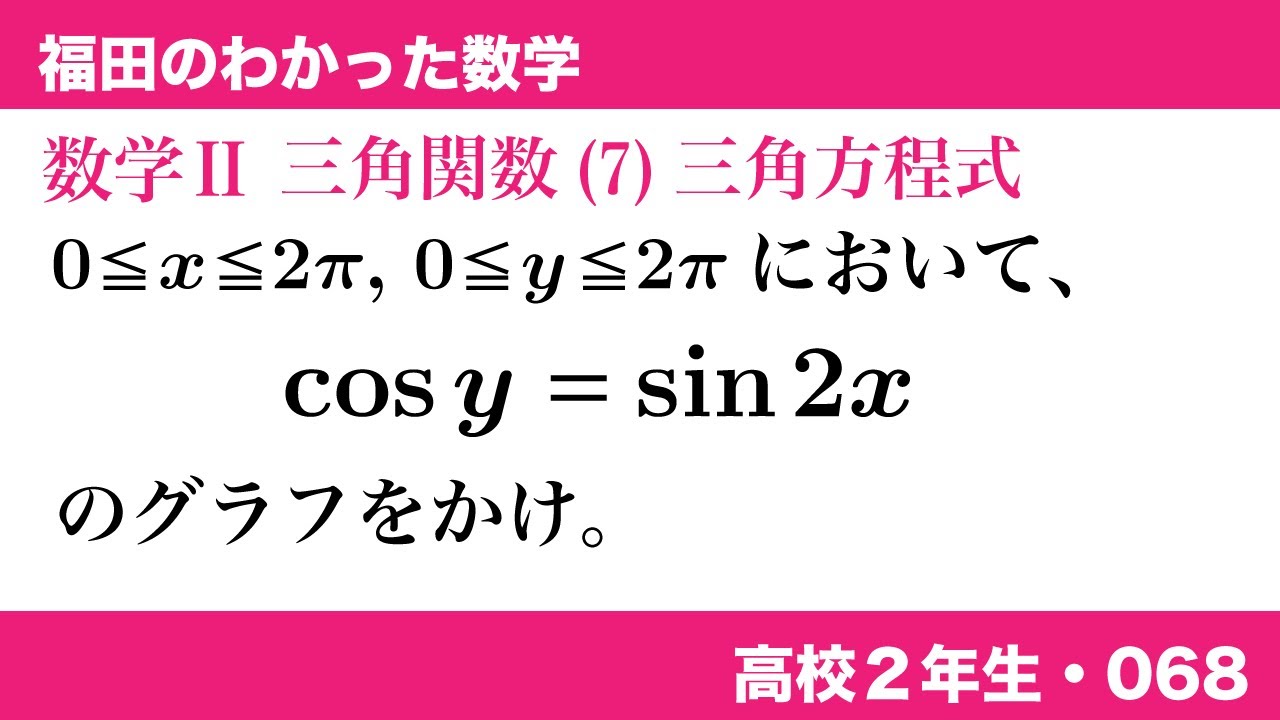
単元:
#数Ⅱ#複素数と方程式#三角関数#剰余の定理・因数定理・組み立て除法と高次方程式#三角関数とグラフ#数学(高校生)
指導講師:
福田次郎
問題文全文(内容文):
数学$\textrm{II}$ 三角関数(7) 三角方程式
$0 \leqq x \leqq 2\pi, 0 \leqq y \leqq 2\pi$において
$\cos y=\sin2x$ のグラフを描け。
この動画を見る
数学$\textrm{II}$ 三角関数(7) 三角方程式
$0 \leqq x \leqq 2\pi, 0 \leqq y \leqq 2\pi$において
$\cos y=\sin2x$ のグラフを描け。
福田のわかった数学〜高校2年生067〜三角関数(6)三角方程式
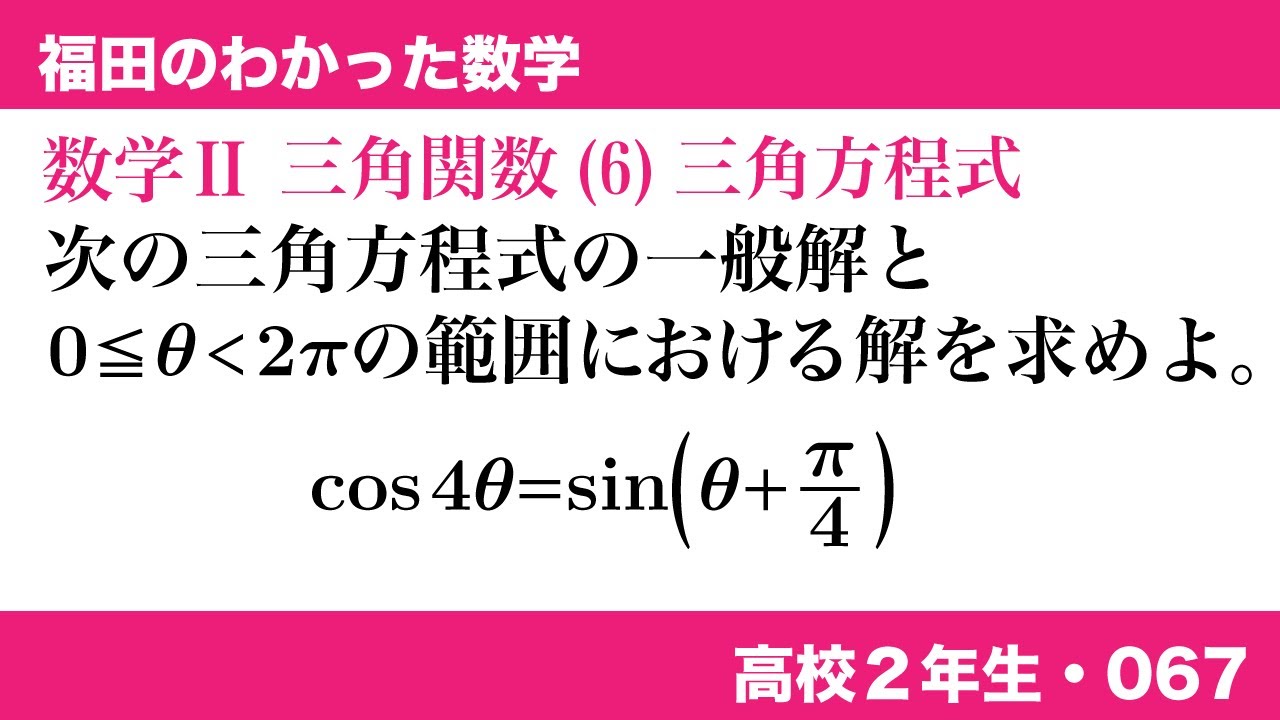
単元:
#数Ⅱ#複素数と方程式#三角関数#剰余の定理・因数定理・組み立て除法と高次方程式#三角関数とグラフ#数学(高校生)
指導講師:
福田次郎
問題文全文(内容文):
数学$\textrm{II}$ 三角関数(6) 三角方程式
次の三角方程式の一般解と$0 \leqq \theta \lt 2\pi$における解を求めよ。
$\cos4\theta=\sin(\theta+\frac{\pi}{4})$
この動画を見る
数学$\textrm{II}$ 三角関数(6) 三角方程式
次の三角方程式の一般解と$0 \leqq \theta \lt 2\pi$における解を求めよ。
$\cos4\theta=\sin(\theta+\frac{\pi}{4})$
福田のわかった数学〜高校2年生066〜三角関数(5)三角方程式

単元:
#数Ⅱ#複素数と方程式#図形と方程式#三角関数#剰余の定理・因数定理・組み立て除法と高次方程式#三角関数とグラフ#数学(高校生)
指導講師:
福田次郎
問題文全文(内容文):
数学$\textrm{II}$ 三角関数(5) 三角方程式
定角$\alpha$に対して次の一般解を求めよ。
(1)$\sin x=\sin\alpha$ (2)$\cos x=\cos\alpha$
(3)$\tan x=\tan\alpha$
この動画を見る
数学$\textrm{II}$ 三角関数(5) 三角方程式
定角$\alpha$に対して次の一般解を求めよ。
(1)$\sin x=\sin\alpha$ (2)$\cos x=\cos\alpha$
(3)$\tan x=\tan\alpha$
福田の数学〜立教大学2021年経済学部第1問(2)〜円に内接する四角形
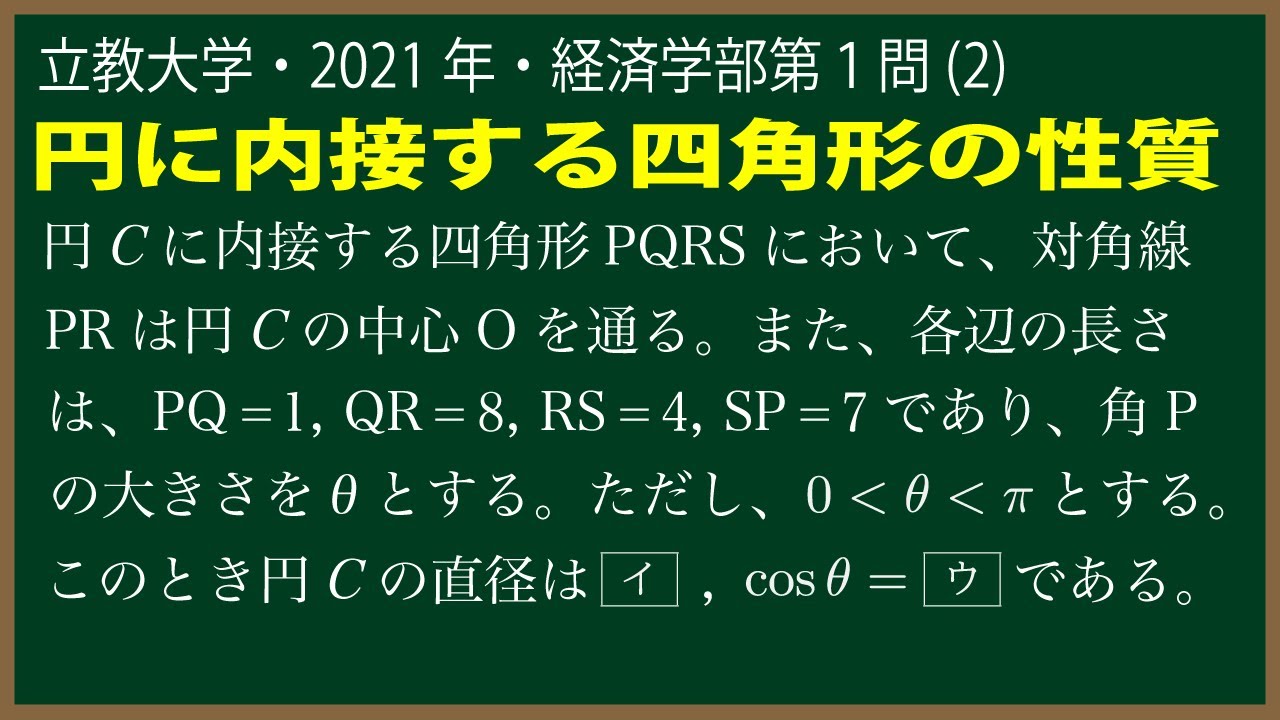
単元:
#数A#数Ⅱ#大学入試過去問(数学)#図形の性質#周角と円に内接する四角形・円と接線・接弦定理#三角関数#三角関数とグラフ#学校別大学入試過去問解説(数学)#立教大学#数学(高校生)
指導講師:
福田次郎
問題文全文(内容文):
${\Large\boxed{1}}$(2)円Cに内接する四角形PQRSにおいて、対角線PRは円Cの中心Oを通る。
また、各辺の長さは、$PQ=1, QR=8, RS=4, SP=7$であり、
角Pの大きさを$\theta$とする。ただし、$0 \lt \theta \lt \pi$とする。
このとき円Cの直径は$\boxed{イ},\cos\theta=\boxed{ウ}$である。
2021立教大学経済学部過去問
この動画を見る
${\Large\boxed{1}}$(2)円Cに内接する四角形PQRSにおいて、対角線PRは円Cの中心Oを通る。
また、各辺の長さは、$PQ=1, QR=8, RS=4, SP=7$であり、
角Pの大きさを$\theta$とする。ただし、$0 \lt \theta \lt \pi$とする。
このとき円Cの直径は$\boxed{イ},\cos\theta=\boxed{ウ}$である。
2021立教大学経済学部過去問
福田のわかった数学〜高校2年生065〜三角関数(4)三角不等式の基礎
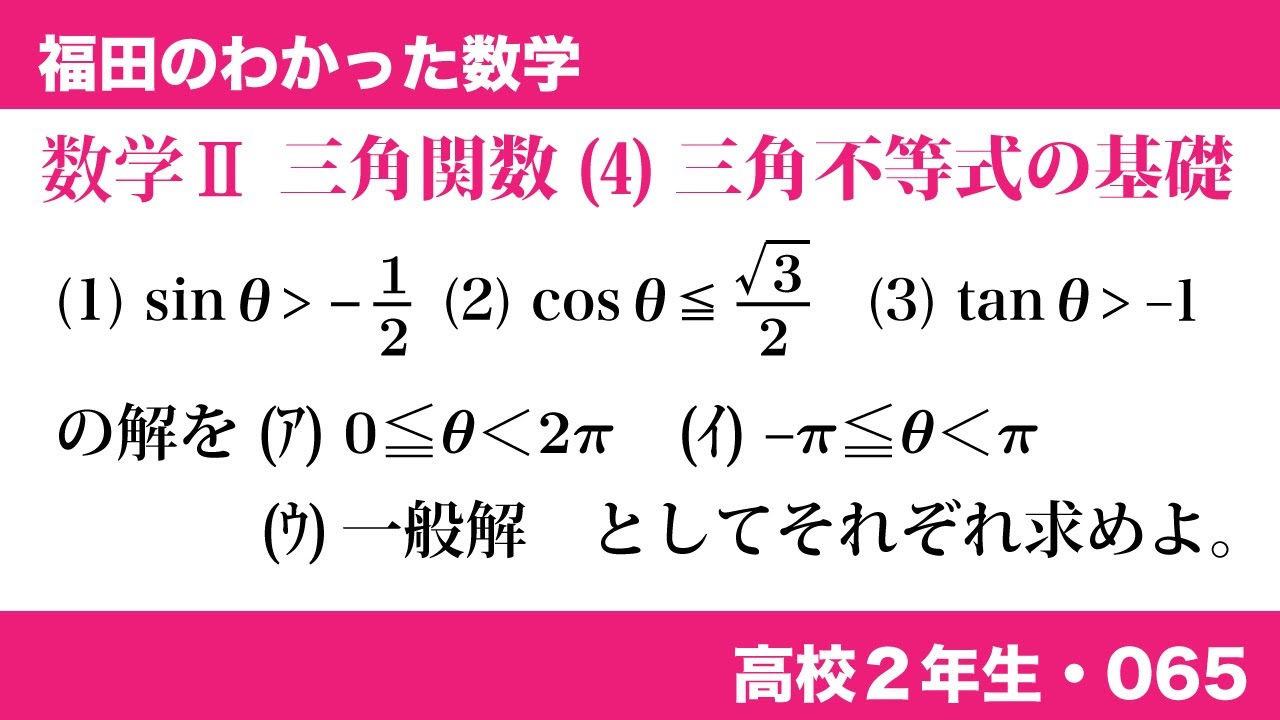
単元:
#数Ⅱ#式と証明#三角関数#恒等式・等式・不等式の証明#三角関数とグラフ#数学(高校生)
指導講師:
福田次郎
問題文全文(内容文):
数学$\textrm{II}$ 三角関数(4) 三角不等式の基礎
(1)$\sin\theta \gt -\frac{1}{2}$ (2)$\cos\theta \leqq \frac{\sqrt3}{2}$ (3)$\tan\theta \gt -1$
の解を(ア)$0 \leqq \theta \lt 2\pi$ (イ)$-\pi \leqq \theta \lt \pi$
(ウ)一般解 としてそれぞれ求めよ。
この動画を見る
数学$\textrm{II}$ 三角関数(4) 三角不等式の基礎
(1)$\sin\theta \gt -\frac{1}{2}$ (2)$\cos\theta \leqq \frac{\sqrt3}{2}$ (3)$\tan\theta \gt -1$
の解を(ア)$0 \leqq \theta \lt 2\pi$ (イ)$-\pi \leqq \theta \lt \pi$
(ウ)一般解 としてそれぞれ求めよ。
福田の数学〜立教大学2021年理学部第2問〜2直線のなす角の最大

単元:
#数Ⅱ#大学入試過去問(数学)#三角関数#加法定理とその応用#学校別大学入試過去問解説(数学)#立教大学#数学(高校生)
指導講師:
福田次郎
問題文全文(内容文):
${\Large\boxed{2}}$座標平面において、放物線$y=x^2$上の点でx座標が$p,p+1,p+2$である点を
それぞれ$P,Q,R$とする。また、直線PQの傾きを$m_1$、直線PRの傾きを$m_2$、
$\angle QPR=\theta$とする。
(1)$m_1,\ m_2$をそれぞれ$p$を用いて表せ。
(2)$p$が実数全体を動くとき、$m_1m_2$の最小値を求めよ。
(3)$\tan\theta$を$p$を用いて表せ。
(4)$p$が実数全体を動くとき、$\theta$が最大になる$p$の値を求めよ。
2021立教大学理工学部過去問
この動画を見る
${\Large\boxed{2}}$座標平面において、放物線$y=x^2$上の点でx座標が$p,p+1,p+2$である点を
それぞれ$P,Q,R$とする。また、直線PQの傾きを$m_1$、直線PRの傾きを$m_2$、
$\angle QPR=\theta$とする。
(1)$m_1,\ m_2$をそれぞれ$p$を用いて表せ。
(2)$p$が実数全体を動くとき、$m_1m_2$の最小値を求めよ。
(3)$\tan\theta$を$p$を用いて表せ。
(4)$p$が実数全体を動くとき、$\theta$が最大になる$p$の値を求めよ。
2021立教大学理工学部過去問
福田のわかった数学〜高校2年生064〜三角関数(3)三角方程式の基礎

単元:
#数Ⅱ#複素数と方程式#図形と方程式#三角関数#剰余の定理・因数定理・組み立て除法と高次方程式#三角関数とグラフ#数学(高校生)
指導講師:
福田次郎
問題文全文(内容文):
数学$\textrm{II}$ 三角関数(3) 三角方程式の基礎
(1)$\sin\theta=-\frac{1}{2}$ (2)$\cos\theta=\frac{\sqrt3}{2}$ (3)$\tan\theta=-1$
の解を(ア)$0 \leqq \theta \lt 2\pi$ (イ)$-\pi \leqq \theta \lt \pi$
(ウ)一般解 としてそれぞれ求めよ。
この動画を見る
数学$\textrm{II}$ 三角関数(3) 三角方程式の基礎
(1)$\sin\theta=-\frac{1}{2}$ (2)$\cos\theta=\frac{\sqrt3}{2}$ (3)$\tan\theta=-1$
の解を(ア)$0 \leqq \theta \lt 2\pi$ (イ)$-\pi \leqq \theta \lt \pi$
(ウ)一般解 としてそれぞれ求めよ。
福田のわかった数学〜高校2年生063〜三角関数(2)三角関数の定義
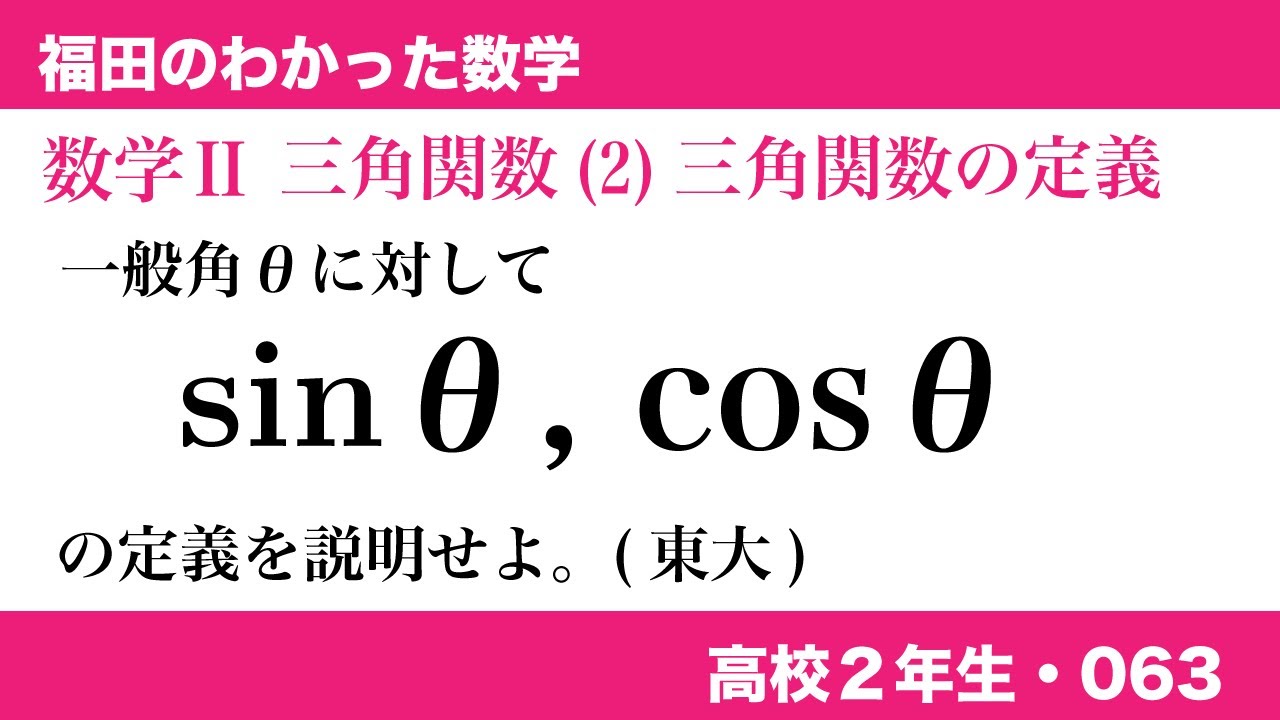
単元:
#数Ⅱ#三角関数#数学(高校生)
指導講師:
福田次郎
問題文全文(内容文):
数学$\textrm{II}$ 三角関数(2) 三角関数の定義
一般角$\theta$に対して
$\sin\theta, \cos\theta$
の定義を説明せよ。
この動画を見る
数学$\textrm{II}$ 三角関数(2) 三角関数の定義
一般角$\theta$に対して
$\sin\theta, \cos\theta$
の定義を説明せよ。
福田のわかった数学〜高校3年生理系080〜グラフを描こう(2)三角関数のグラフ

単元:
#数Ⅱ#三角関数#三角関数とグラフ#数学(高校生)
指導講師:
福田次郎
問題文全文(内容文):
数学$\textrm{III}$ グラフを描こう(2)
$y=\cos2x-2\cos x (0 \leqq x \leqq 2\pi)$
のグラフを描け。ただし凹凸は調べなくてよい。
この動画を見る
数学$\textrm{III}$ グラフを描こう(2)
$y=\cos2x-2\cos x (0 \leqq x \leqq 2\pi)$
のグラフを描け。ただし凹凸は調べなくてよい。
福田のわかった数学〜高校2年生062〜三角関数(1)三角関数のグラフ
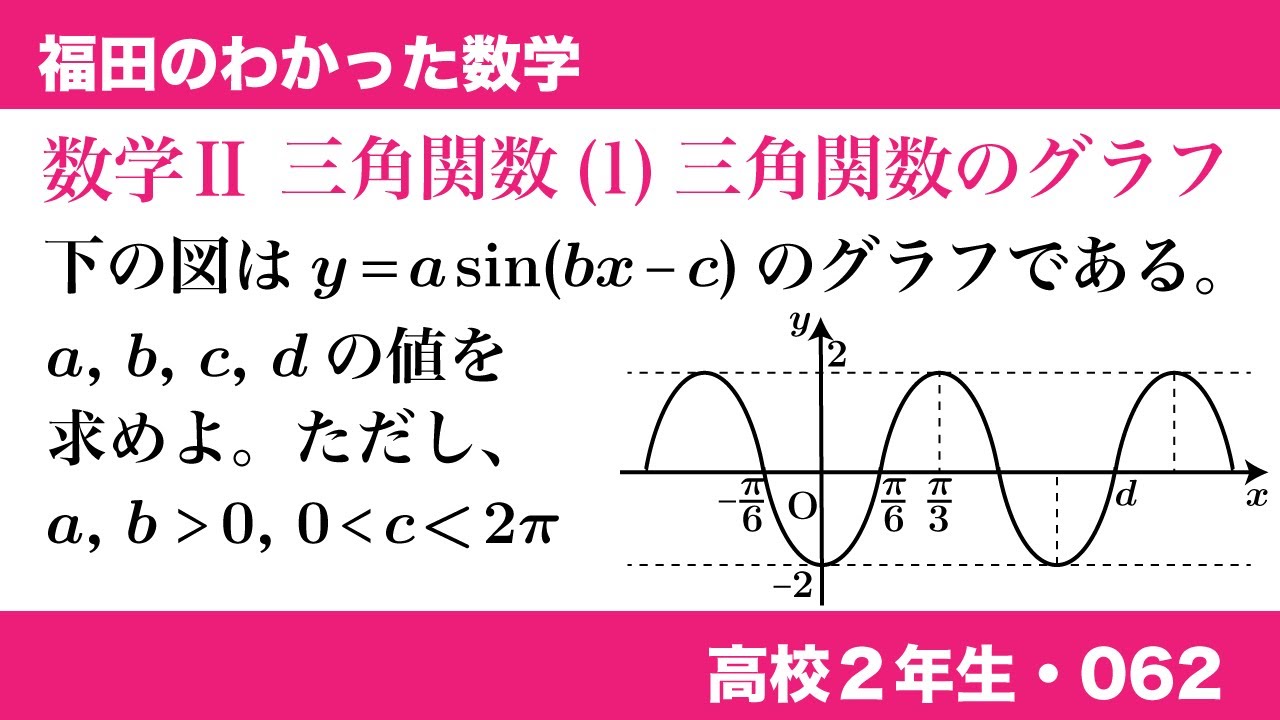
単元:
#数Ⅱ#三角関数#三角関数とグラフ#数学(高校生)
指導講師:
福田次郎
問題文全文(内容文):
数学$\textrm{II}$ 三角関数(1) 三角関数のグラフ
下の図は$y=a\sin(bx-c)$のグラフである。
$a,b,c,d$の値を求めよ。ただし、$a \gt 0,\ b \gt 0,\ 0 \lt c \lt 2\pi$
とする。(※図は動画参照)
この動画を見る
数学$\textrm{II}$ 三角関数(1) 三角関数のグラフ
下の図は$y=a\sin(bx-c)$のグラフである。
$a,b,c,d$の値を求めよ。ただし、$a \gt 0,\ b \gt 0,\ 0 \lt c \lt 2\pi$
とする。(※図は動画参照)
